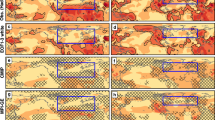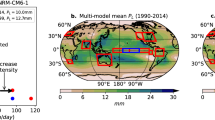Abstract
The evidence for anthropogenic climate change continues to strengthen, and concerns about severe weather events are increasing. As a result, scientific interest is rapidly shifting from detection and attribution of global climate change to prediction of its impacts at the regional scale. However, nearly everything we have any confidence in when it comes to climate change is related to global patterns of surface temperature, which are primarily controlled by thermodynamics. In contrast, we have much less confidence in atmospheric circulation aspects of climate change, which are primarily controlled by dynamics and exert a strong control on regional climate. Model projections of circulation-related fields, including precipitation, show a wide range of possible outcomes, even on centennial timescales. Sources of uncertainty include low-frequency chaotic variability and the sensitivity to model error of the circulation response to climate forcing. As the circulation response to external forcing appears to project strongly onto existing patterns of variability, knowledge of errors in the dynamics of variability may provide some constraints on model projections. Nevertheless, higher scientific confidence in circulation-related aspects of climate change will be difficult to obtain. For effective decision-making, it is necessary to move to a more explicitly probabilistic, risk-based approach.
This is a preview of subscription content, access via your institution
Access options
Subscribe to this journal
Receive 12 print issues and online access
$259.00 per year
only $21.58 per issue
Buy this article
- Purchase on Springer Link
- Instant access to full article PDF
Prices may be subject to local taxes which are calculated during checkout




Similar content being viewed by others
References
IPCC Climate Change 2013: The Physical Science Basis (eds Stocker, T. F. et al.) (Cambridge Univ. Press, 2013).
Met Office The Recent Storms and Floods in the UK (Met Office, 2014); http://www.metoffice.gov.uk/media/pdf/1/2/Recent_Storms_Briefing_Final_SLR_20140211.pdf
Bühler, T., Raible, C. C. & Stocker, T. F. The relationship of winter season North Atlantic blocking frequencies to extreme cold or dry spells in the ERA-40. Tellus A 63, 212–222 (2011).
Screen, J. A. & Simmonds, I. Amplified mid-latitude planetary waves favour particular regional weather extremes. Nature Clim. Change 4, 704–709 (2014).
Turner, A. G. & Annamalai, H. Climate change and the South Asian summer monsoon. Nature Clim. Change 2, 587–595 (2012).
Lin, M., Horowitz, L. W., Oltmans, S. J., Fiore, A. M. & Fan, S. Tropospheric ozone trends at Mauna Loa Observatory tied to decadal climate variability. Nature Geosci. 7, 136–143 (2014).
IPCC Managing the Risks of Extreme Events and Disasters to Advance Climate Change Adaptation (eds Field, C. B. et al.) (Cambridge Univ. Press, 2012).
Knutti, R. & Sedlacek, J. Robustness and uncertainties in the new CMIP5 climate model projections. Nature Clim. Change 3, 369–373 (2013).
Stott, P. A. et al. External control of 20th century temperature by natural and anthropogenic forcings. Science 290, 2133–2137 (2000).
Hoskins, B. J. in Large-Scale Dynamical Processes in the Atmosphere (eds Hoskins, B. J. & Pearce, R. P.) 169–199 (Academic Press, 1983).
Deser, C., Magnusdottir, G., Saravanan, R. & Phillips, A. The effects of North Atlantic SST and sea ice anomalies on the winter circulation in CCM3. Part II: Direct and indirect components of the response. J. Clim. 17, 877–889 (2004).
Simpson, I. R., Blackburn, M. & Haigh, J. D. The role of eddies in driving the tropospheric response to stratospheric heating perturbations. J. Atmos. Sci. 66, 1347–1365 (2009).
Held, I. M. & Hoskins, B. J. Large-scale eddies and the general circulation of the troposphere. Adv. Geophys. 28A, 3–31 (1985).
Bony, S. et al. Robust direct effect of carbon dioxide on tropical circulation and regional precipitation. Nature Geosci. 6, 447–451 (2013).
Chadwick, R., Boutle, I. & Martin, G. Spatial patterns of precipitation change in CMIP5: Why the rich do not get richer in the tropics. J. Clim. 27, 3803–3822 (2013).
Strogatz, S. H. Nonlinear Dynamics and Chaos: With Applications to Physics, Biology, Chemistry, and Engineering (Perseus Books, 1994).
Palmer, T. N. A nonlinear dynamical perspective on climate prediction. J. Clim. 12, 575–591 (1999).
Wunsch, C. The interpretation of short climate records, with comments on the North Atlantic and Southern Oscillations. Bull. Am. Meteorol. Soc. 80, 245–255 (1999).
Shin, S-I. & Sardeshmukh, P. D. Critical influence of the pattern of tropical ocean warming on remote climate trends. Clim. Dynam. 36, 1577–1591 (2011).
Deser, C., Phillips, A., Bourdette, V. & Teng, H. Y. Uncertainty in climate change projections: the role of internal variability. Clim. Dynam. 38, 527–546 (2012).
Deser, C., Phillips, A. S., Alexander, M. A. & Smoliak, B. V. Projecting North American climate over the next 50 years: uncertainty due to internal variability. J. Clim. 27, 2271–2296 (2014).
Palmer, T. N. & Räisänen, J. Quantifying the risk of extreme seasonal precipitation events in a changing climate. Nature 415, 512–514 (2002).
Hawkins, E. & Sutton, R. The potential to narrow uncertainty in projections of regional precipitation change. Clim. Dynam. 37, 407–418 (2011).
Fedorov, A. V. & Philander, S. G. A stability analysis of tropical ocean–atmosphere interactions: bridging measurements and theory for El Niño. J. Clim. 14, 3086–3101 (2001).
Hall, N. M. J., Derome, J. & Lin, H. The extratropical signal generated by a midlatitude SST anomaly. Part I: Sensitivity at equilibrium. J. Clim. 14, 2035–2053 (2001).
Sigmond, M. & Scinocca, J. F. The influence of the basic state on the Northern Hemisphere circulation response to climate change. J. Clim. 23, 1434–1446 (2010).
Scaife, A. A. et al. Climate change projections and stratosphere–troposphere interaction. Clim. Dynam. 38, 2089–2097 (2012).
Garfinkel, C. I., Waugh, D. W. & Gerber, E. P. The effect of tropospheric jet latitude on coupling between the stratospheric polar vortex and the troposphere. J. Clim. 26, 2077–2095 (2013).
Chen, G., Held, I. M. & Robinson, W. A. Sensitivity of the latitude of the surface westerlies to surface friction. J. Atmos. Sci. 64, 2899–2915 (2007).
Stevens, B. & Bony, S. What are climate models missing? Science 340, 1053–1054 (2013).
Sandu, I., Beljaars, A., Bechtold, P., Mauritsen, T. & Balsamo, G. Why is it so difficult to represent stably stratified conditions in numerical weather prediction (NWP) models? J. Adv. Model. Earth Syst. 5, 117–133 (2013).
Nyquist, H. Thermal agitation of electric charge in conductors. Phys. Rev. 32, 110–113 (1928).
Chen, G. & Plumb, R. A. Quantifying the eddy feedback and the persistence of the zonal index in an idealized atmospheric model. J. Atmos. Sci. 66, 3707–3720 (2009).
Son, S-W. & Lee, S. The response of westerly jets to thermal driving in a primitive equation model. J. Atmos. Sci. 62, 3741–3757 (2005).
Tandon, N. F., Gerber, E. P., Sobel, A. H. & Polvani, L. M. Understanding Hadley cell expansion versus contraction: insights from simplified models and implications for recent observations. J. Clim. 26, 4304–4321 (2013).
Branstator, G. & Selten, F. ''Modes of variability'' and climate change. J. Clim. 22, 2639–2658 (2009).
Gritsun, A. & Branstator, G. Climate response using a three-dimensional operator based on the fluctuation–dissipation theorem. J. Atmos. Sci. 64, 2558–2575 (2007).
Keeley, S. P. E., Sutton, R. T. & Shaffrey, L. C. Does the North Atlantic Oscillation show unusual persistence on intraseasonal timescales? Geophys. Res. Lett. 36, L22706 (2009).
Simpson, I. R., Shepherd, T. G., Hitchcock, P. & Scinocca, J. F. Southern Annular Mode dynamics in observations and models. Part 2: Eddy feedbacks. J. Clim. 26, 5220–5241 (2013).
Ring, M. J. & Plumb, R. A. The response of a simplified GCM to axisymmetric forcings: applicability of the fluctuation–dissipation theorem. J. Atmos. Sci. 65, 3880–3898 (2008).
Corti, S., Molteni, F. & Palmer, T. N. Signature of recent climate change in frequencies of natural atmospheric circulation regimes. Nature 398, 799–802 (1999).
van Oldenborgh, G. J., Doblas Reyes, F. J., Drijfhout, S. S. & Hawkins, E. Reliability of regional climate model trends. Environ. Res. Lett. 8, 014055 (2013).
Hitchcock, P., Shepherd, T. G. & Manney, G. L. Statistical characterization of Arctic polar-night jet oscillation events. J. Clim. 26, 2096–2116 (2013).
McLandress, C., Shepherd, T. G., Polavarapu, S. & Beagley, S. R. Is missing orographic gravity wave drag near 60°S the cause of the stratospheric zonal wind biases in chemistry–climate models? J. Atmos. Sci. 69, 802–818 (2012).
Knutti, R., Masson, D. & Gettelman, A. Climate model genealogy: generation CMIP5 and how we got there. Geophys. Res. Lett. 40, 1194–1199 (2013).
Hall, A. & Qu, X. Using the current seasonal cycle to constrain snow albedo feedback in future climate change. Geophys. Res. Lett. 33, L03502 (2006).
Cox, P. M. et al. Sensitivity of tropical carbon to climate change constrained by carbon dioxide variability. Nature 494, 341–344 (2013).
Coughlan de Perez, E., Monasso, F., van Aalst, M. & Suarez, P. Science to prevent disasters. Nature Geosci. 7, 78–79 (2014).
Sandeep, S., Stordal, F., Sardeshmukh, P. D. & Compo, G. Pacific Walker circulation variability in coupled and uncoupled climate models. Clim. Dynam. 43, 103–117 (2014).
Meier, W. N., Stroeve, J., Barrett, A. & Fetterer, F. A simple approach to providing a more consistent Arctic sea ice extent time series from the 1950s to present. Cryosphere 6, 1359–1368 (2012).
Acknowledgements
The author acknowledges the support provided through the Grantham Chair in Climate Science at the University of Reading. Helpful comments on the manuscript were provided by S. Bony, I. Held, B. Hoskins and M. Hegglin.
Author information
Authors and Affiliations
Corresponding author
Ethics declarations
Competing interests
The author declares no competing financial interests.
Rights and permissions
About this article
Cite this article
Shepherd, T. Atmospheric circulation as a source of uncertainty in climate change projections. Nature Geosci 7, 703–708 (2014). https://doi.org/10.1038/ngeo2253
Received:
Accepted:
Published:
Issue Date:
DOI: https://doi.org/10.1038/ngeo2253
This article is cited by
-
Differences in spatial niche of terrestrial mammals when facing extreme snowfall: the case in east Asian forests
Frontiers in Zoology (2024)
-
Projected amplification of summer marine heatwaves in a warming Northeast Pacific Ocean
Communications Earth & Environment (2024)
-
The subseasonal predictability of the western North Pacific subtropical high and the 2020 record-breaking event
npj Climate and Atmospheric Science (2024)
-
Assessing the Performance of a Dynamical Downscaling Simulation Driven by a Bias-Corrected CMIP6 Dataset for Asian Climate
Advances in Atmospheric Sciences (2024)
-
A joint framework for studying compound ecoclimatic events
Nature Reviews Earth & Environment (2023)



